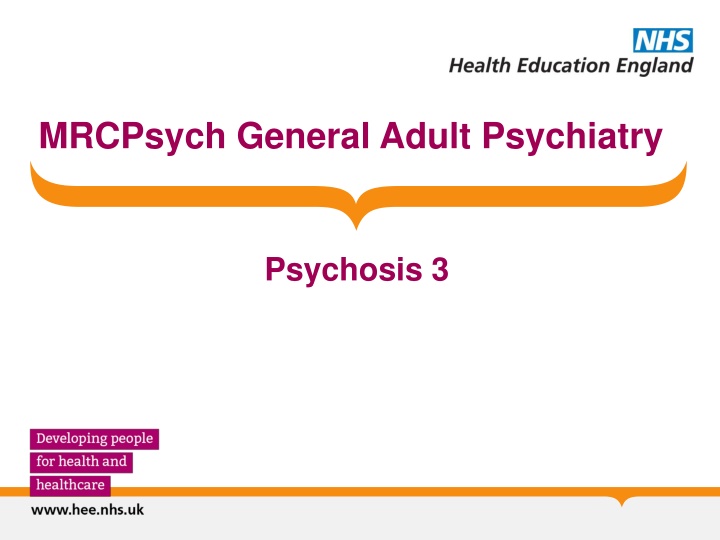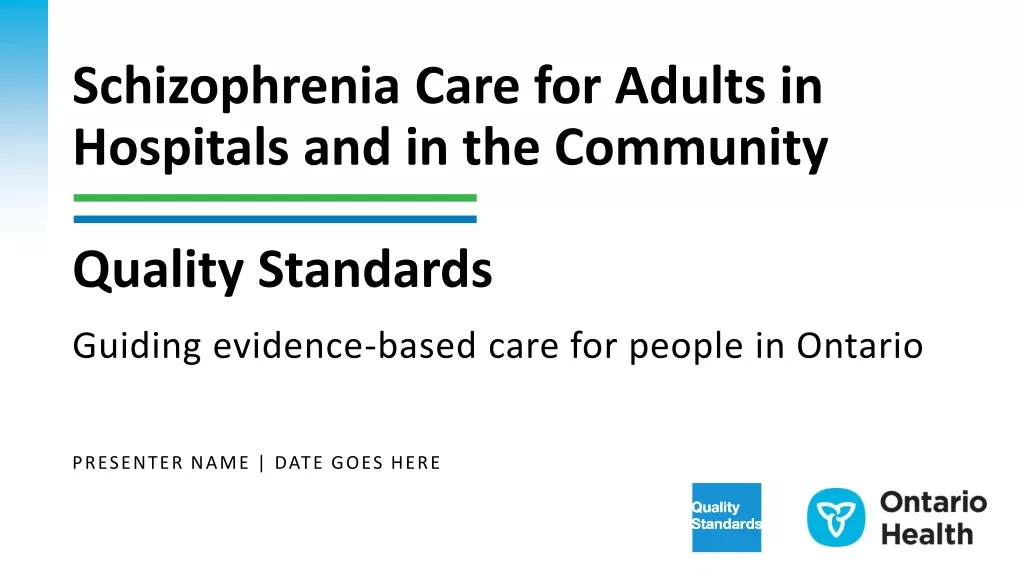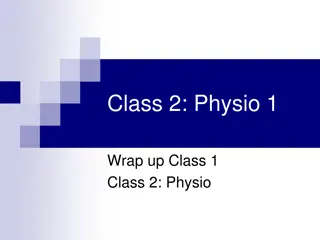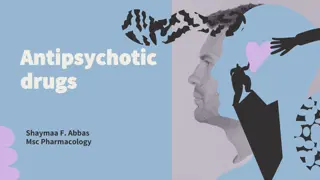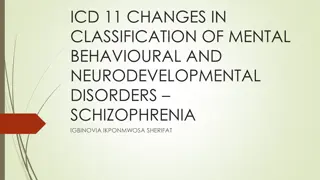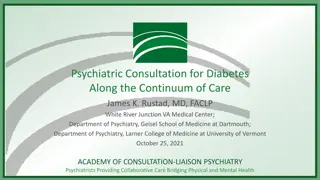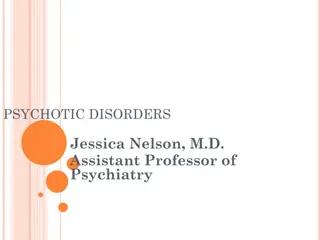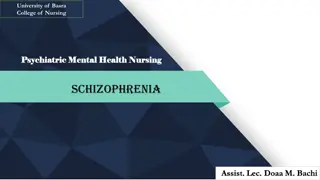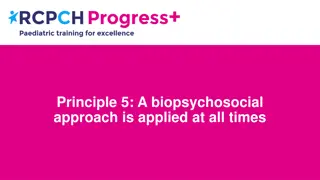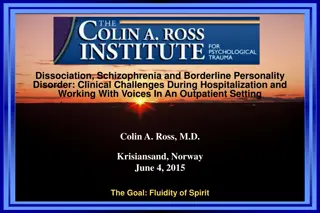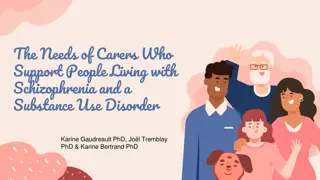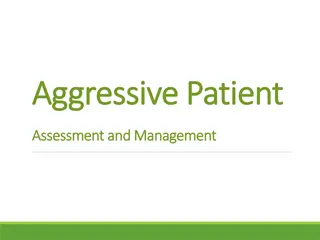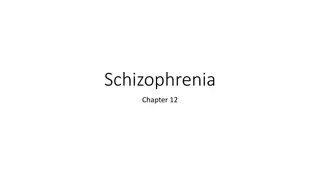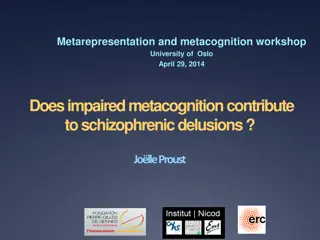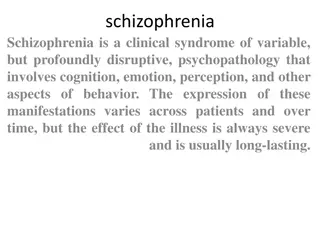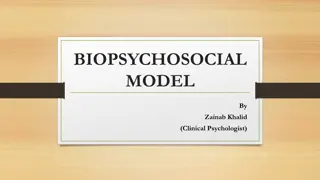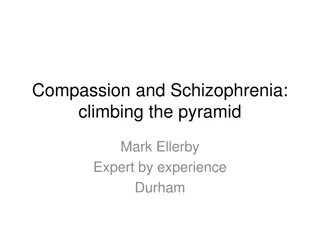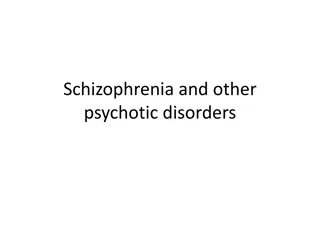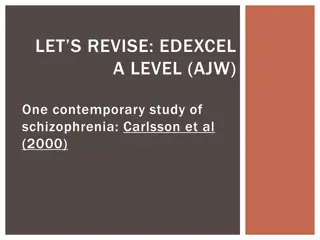Biopsychosocial Treatment of Schizophrenia
In-depth exploration of the biopsychosocial management and evidence-based treatment of schizophrenia, including pharmacological and non-pharmacological interventions, hospitalization goals, and focus on self-care in treatment. Discussion on the complexity of schizophrenia and different types of antipsychotics.
Download Presentation

Please find below an Image/Link to download the presentation.
The content on the website is provided AS IS for your information and personal use only. It may not be sold, licensed, or shared on other websites without obtaining consent from the author.If you encounter any issues during the download, it is possible that the publisher has removed the file from their server.
You are allowed to download the files provided on this website for personal or commercial use, subject to the condition that they are used lawfully. All files are the property of their respective owners.
The content on the website is provided AS IS for your information and personal use only. It may not be sold, licensed, or shared on other websites without obtaining consent from the author.
E N D
Presentation Transcript
MRCPsych General Adult Psychiatry Psychosis 3
Psychosis 3 Objectives To develop an understanding of: the biopsychosocial management of schizophrenia evidence based treatment
Psychosis 3 Expert Led Session Schizophrenia: biopsychosocial management and evidence-based treatment
Overview introduction pharmacological interventions NICE guidelines non-pharmacological interventions summary
Introduction antipsychotics psychosocial interventions psychotherapy
Biopsychosocial approach complexity of schizophrenia any single therapeutic approach inadequate to deal with the multifactorial disorder
Primary goals of hospitalisation diagnostic purposes medication stabilization safety of patients and others grossly disorganized behaviour effective association between patients and community support systems
Treatment in hospital Focus self-care quality of life employment social relationships Aftercare facilities
Pharmacotherapy chlorpromazine 1952 placebo-controlled clinical trials of antipsychotics in the acute phase of schizophrenia consistently demonstrated that the active drug is significantly more effective pharmacological properties all share capacity to anatagonise postsynaptic dopamine receptors, with consistent level of dopamine blockade within few days some side effects in most patients
Different types of antipsychotics pharmacology kinetics overall efficacy/effectiveness tolerability
1st vs 2nd generation antipsychotics typicals or first generation (FGAs) atypicals or second generation (SGAs) difference = size of therapeutic index in relation to acute EPSEs e.g. haloperidol has a very narrow index <0.5 mg/day olanzapine has a wide index 20-40mg/day
Evidence CATIE & CUtLASS 51 FGAs vs 11 SGAs no convincing evidence to support advantage for SGAs over FGAs (possible exception of clozapine & 0lanzapine ) Leucht S et al. comparative efficacy & tolerability of 15 antipsychotic drugs in schizophrenia: multiple treatment metanalysis lancet 2013 ranking: clozapine 1st, amisulpride 2nd and olanzapine 3rd difference is small but potentially substantial enough to be clinically important
Side effects for both FGAs & SGAs common reason for treatment discontinuation psychiatrists views of prevalence & importance of adverse effects differs markedly from patients experience
Acute phase average duration 4-8 weeks immediate attention alleviate psychotic symptoms manage agitation longer duration of untreated psychosis (DUP) = worse prognosis
First episode psychosis early intervention in psychosis services should be accessible to all people with a first episode or first presentation of psychosis choice of antipsychotic medication should be made by the patient and healthcare professional together, taking into account the views of the carer, if the service user agrees
First episode psychosis initiate antipsychotic at low licensed dosage range first-episode psychosis responds to lower doses of antipsychotic medication than those required for the treatment of established schizophrenia document review of change in symptom and side effects in the clinical records, with the rationale for any change in medication or its continuation adequate trial: optimum dosage with good compliance for 4 weeks
First episode psychosis for FGAs: medium or low-potency drug rather than high potency drug anticholinergic agents should only be used for emergent extrapyramidal problems (not prophylactically)
Pharmacotherapy many respond to antipsychotic drugs initially around 80% relapse within five years (discontinuation of medication, side effects) 75% recurrently relapse, leading to disability, but there is a moderately good long term global outcome in over half
Risk of relapse within a year 16%-23% on treatment 53%-72% without treatment patients with one episode have a 4:5 chance of relapsing stopping antipsychotics increases this risk 5 folds
Length of treatment with antipsychotic after the first episode consensus guidelines recommend continued antipsychotic medication for 1 2 years (Buchanan et al., 2010; National Institute for Health and Clinical Excellence,2009b) recent data suggest 1-2 years maintenance is not enough some recommend treatment for at least 5 years; other indefinitely
Non-compliance very high rate up to 25% partially or non compliant at 10 days post discharge up to 50% at 1 year; up to 75% at 2 years increased risk of relapse, severity of relapse, duration of hospitalization, suicide attempts by four-fold
Long-acting depot injection active drug in an oily suspension associated with a reduced risk of relapse and re- hospitilisation FGAs & SGAs
Treatment resistant schizophrenia failure to respond to two or more antipsychotic medications given in therapeutic doses for 6 weeks or more approx 30% of patients respond poorly to antipsychotics about 7% show total non-response
Treatment resistant schizophrenia- management clarify diagnosis address comorbidity consider non-compliance pharmacology: clozapine, then augment rehabilitation
Relapse prevention continued prescription of antipsychotics to prevent relapse, maintain long-term control of symptoms/behaviour and improve quality of life individuals achieving greater improvement in symptoms with optimal pharmacotherapy benefit more from psychosocial interventions small number of longer-term, relapse prevention trials data insufficient to allow assessment of the relative merits of individual antipsychotics
Monitoring of antipsychotic medication-NICE responsibility of secondary care team to monitor service users physical health and effects of antipsychotic medication for at least the first 12 months or until condition stabilized afterwards, the responsibility may be transferred to primary care under shared care arrangements
Non-pharmacological interventions address impairments in social, vocational, and educational functioning focus -physical health, smoking cessation -patient and family education -skills training -supported employment
Psychological therapies NICE CBT to all people with psychosis or schizophrenia family intervention to all families of people with psychosis or schizophrenia who live with or are in close contact with the patient consider arts therapies to all people with psychosis or schizophrenia (alleviation of negative symptoms)
CBT for psychosis 1:1 basis over at least 16 sessions establishes links between thoughts, feelings or actions and current/past symptoms, and/or functioning re-evaluation of people's perceptions, beliefs or reasoning relating to the target symptoms
CBT for psychosis Factors for successful CBT early work with acutely psychotic inpatients (Drury et al) female gender (Drury et al, Brabban et al) shorter duration of untreated illness (Drury et al) less severe symptoms (Tarrier et al) low level of conviction in delusions (Brabban et al)
Evidence for CBT for psychosis Jones et al. (2005) - systematic review of 30 papers: 19 trials of CBT for schizophrenia CBT was a promising but under-evaluated intervention for schizophrenia and other psychotic illnesses SoCRATES trial (Lewis et al., 2002): 5-week course of CBTp for people recently admitted to hospital more rapid improvement in symptoms for the group that received CBT relatively modest effect size
Evidence for CBT for psychosis Wykes et al. (2008) meta-analysis of 34 trials of CBT significant inverse relationship between effect size and trial quality smaller, older and poorly funded trials showed a larger effect size rigorous CBTp studies had a moderate effect size (around 0.4) Move away from generic CBT for psychosis towards a symptom specific approach (Steel, 2008) e.g. CBT for command hallucinations
Family intervention family includes people who have a significant emotional connection to the individual, such as parents, siblings and partners 3 months to 1 year at least 10 planned sessions consider family's preference for either single family intervention or multi-family group intervention consider relationship between main carer and the person with psychosis
Family therapy for schizophrenia 16 trials (857 participants): family intervention may reduce the frequency of relapse among patients 8 trials (481 patients): family intervention may reduce hospital admissions 7 trials (369 patients): family intervention may encourage compliance with medication 6 trials (481 patients): it does not apparently effect the tendency of individuals and families to drop out of care (Family intervention for schizophrenia (review) PHAROAH F., et al Publisher:John Wiley and Sons , 2006, 107p., bibliog, Chichester)
Support for carer as early as possible negotiate with patient and carer about how information about the service user will be shared offer carer an assessment offer carer focused education and support programme
Summary antipsychotics do not cure schizophrenia some antipsychotic drugs are more effective than others range of antipsychotics are available; different drugs suit different patients long-term treatment is generally required to prevent relapses antipsychotics should never be stopped suddenly psychological and psychosocial interventions increases the chances of staying well
Psychosis 3 MCQs 1. Which one of the following led a trial that proved Clozapine's effectiveness in treating resistant schizophrenia? A Kretschmer B Cade C Kraepelin D Kane E Bleurer
Psychosis 3 MCQs 1. Which one of the following led a trial that proved Clozapine's effectiveness in treating resistant schizophrenia? A Kretschmer B Cade C Kraepelin D Kane E Bleurer
Psychosis 3 MCQs 2. Choose the correct match from the following pairs: A Risperidone: dibenzoxapine B Droperidol: butyrophenones C Aripiprazole: benzisothiazole D Thioridazine: diphenyl butyl piperidine E Flupentixol: dihydroindole
Psychosis 3 MCQs 2. Choose the correct match from the following pairs: A Risperidone: dibenzoxapine BDroperidol: butyrophenones C Aripiprazole: benzisothiazole D Thioridazine: diphenyl butyl piperidine E Flupentixol: dihydroindole
Psychosis 3 MCQs 3. Which of the following atypical agents have the shortest half life? A Quetiapine B Aripiprazole C Olanzapine D Clozapine E Risperidone
Psychosis 3 MCQs 3. Which of the following atypical agents have the shortest half life? A Quetiapine B Aripiprazole C Olanzapine D Clozapine E Risperidone
Psychosis 3 MCQs 4. The patients who are prescribed clozapine or olanzapine should have their serum lipids measured every: A 6 days whilst on treatment B One year whilst on treatment C 3 months for the first year of treatment D 6 weeks for the first year of treatment E 6 months for the first year of treatment
Psychosis 3 MCQs 4. The patients who are prescribed clozapine or olanzapine should have their serum lipids measured every: A 6 days whilst on treatment B One year whilst on treatment C 3 months for the first year of treatment D 6 weeks for the first year of treatment E 6 months for the first year of treatment
Psychosis 3 MCQs 5. What percentage of patients develop Tardive Dyskinesia with every year of typical antipsychotic exposure? A More than 50% B 2-5% C 5-10% D 20-25% E 10-20%
Psychosis 3 MCQs 5. What percentage of patients develop Tardive Dyskinesia with every year of typical antipsychotic exposure? A More than 50% B 2-5% C 5-10% D 20-25% E 10-20%
Insert name of the module Any Questions? Thank you.
References Psychosis and Schizophrenia in adults The NICE guideline on treatment and management updated edition 2014 SPMM Course HiYield Paper A(2)
